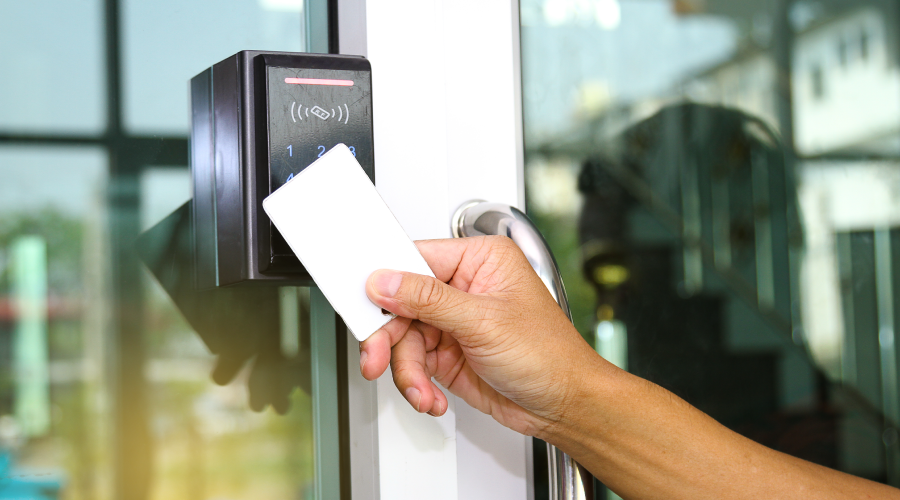Updates To Codes and Technology Aid Door Selection
Codes and technology are both responding to modern door selection needs. Here's what you need to know about updates to NFPA, new wireless access control technology.
Experts recommend that security, life safety, and access control be considered simultaneously when specifying doors and door hardware. Basically, all three need to work together to meet code and security requirements.
NFPA 101: Life Safety Code requires free egress. In other words, occupants must be able to exit the building without using keys, tools, or special knowledge or effort. There are few exceptions to this requirement. For example, in hospitals, nursing homes, and limited care facilities, egress doors may be locked for patient safety such as in psychiatric or dementia care units, as well as in newborn nurseries. But these spaces also have trained personnel to facilitate prompt egress when necessary.
NFPA recognizes the need to keep in mind both life safety and security. “In response to the unfortunate prevalence of active shooter events in recent years, and to underscore the need for balancing safety and security, the 2018 edition of the Life Safety Code will address locked classroom doors in schools, in addition to door locking to prevent unwanted entry in other occupancies,” writes Gregory Harrington, principal engineer for the National Fire Protection Association (NFPA) in “Locked Doors: Security Barricade or Life Safety Hazard?” published by ANSI in April 2017.
With older fire doors that need replacement, Sabatini says he recommends proceeding with caution: “Fire doors installed before the 1980s often contain asbestos in the fire door’s core.”
Door hardware and installation in museums also may require specially crafted hardware. For example, the Salisbury House in Des Moines, Iowa, was once a family mansion. Now, however, the carriage house is a visitor center. But over the years, its original bifold doors had been replaced with windows. The director of the museum wanted the carriage house to reflect its original design and still allow safe entry and egress for large crowds in compliance with local codes.
After much research and study of the blueprints, the architect contacted the original hardware manufacturer for track, hangers, support brackets, strap hinges, back plates, and spring bolts that would be true to the originals. Using laser technology, the company was able to produce these “antique” hardware specialty items. Today, they provide authenticity to the restored museum.
Technological advances
Whether wired or wireless, advances in access control and security hardware offer many options to meet various specific needs. When a computerized door management system is used, facility managers “have an audit trail of who’s been where, how long, and whether they’re authorized or not,” explains Westerkamp.
“Computerized plastic key cards and proximity cards can be restricted so that they work only during certain hours,” notes Westerkamp. “For example, custodial workers can use the cards to open doors during nightly cleaning hours. However, during daylight, those cards may not allow access.”
When security is incorporated into exterior door hardware decisions, Conine says computerized access controls make lockdowns “quicker and more efficient.” Classrooms containing high-tech equipment also can be locked when class ends to secure valuable assets.
In new construction, Sabatini stresses doing the prep work for wired access controls even if they are not scheduled for immediate installation. “It is cost prohibitive to open up an existing wall or flooring to run conduit later,” Sabatini explains.
Conine says that incorporating future needs has saved the University of Southern California money. “We are not going through after the fact, when changing out the door and hardware are more labor intensive,” she says.
Some door security hardware is wireless on the USC campus. But there actually are many different types of access control used at the private university. Conine explains that usage and the features needed at any given door or research laboratory dictate what type is used.
Studies show that academic campuses with an “open feel” are conducive to better learning experiences for students. “Yet we still have to protect people and assets,” Conine says.
Although Sabatini says he likes to embrace technology, he also doesn’t want access controllers that are easily hacked or manipulated. So he prefers door security and access control systems run over a secured intranet rather than on the World Wide Web.
Sabatini also declines opportunities to become a beta site. “Not on my doors,” he says. “The product has to be installed somewhere else, so that I can make a field trip and talk to facility people about their experiences with it. The technology may be the next best widget. But I’m not going to specify it until I’ve seen it installed and observed what it does.”
Rita Tatum, a contributing editor for Building Operating Management, has more than 25 years of experience covering facility design and technology.
Email questions to edward.sullivan@tradepress.com.
Related Topics:













